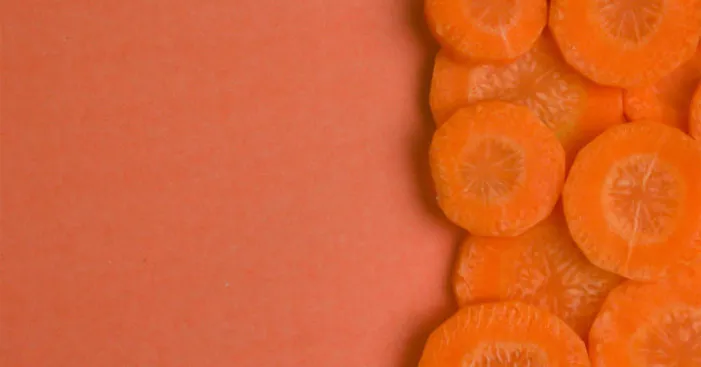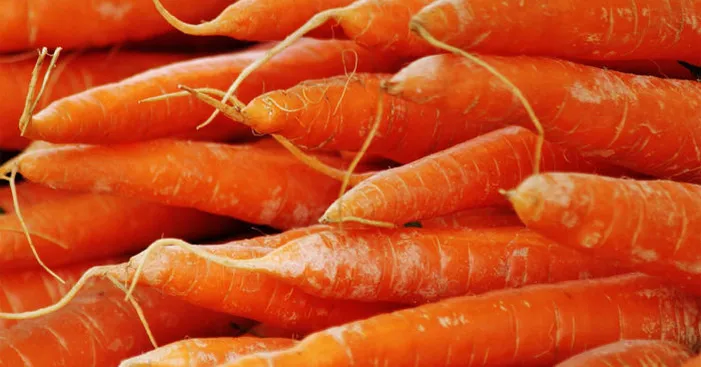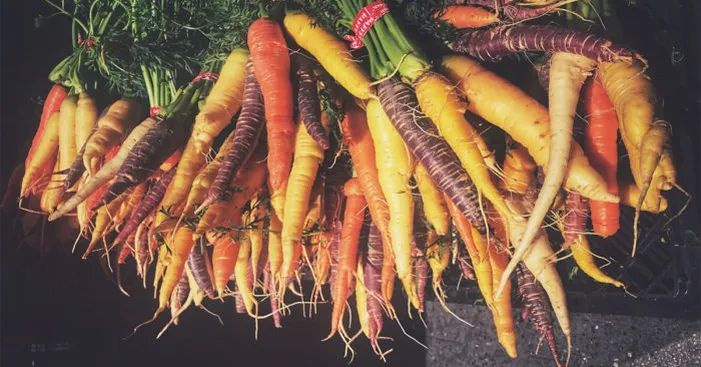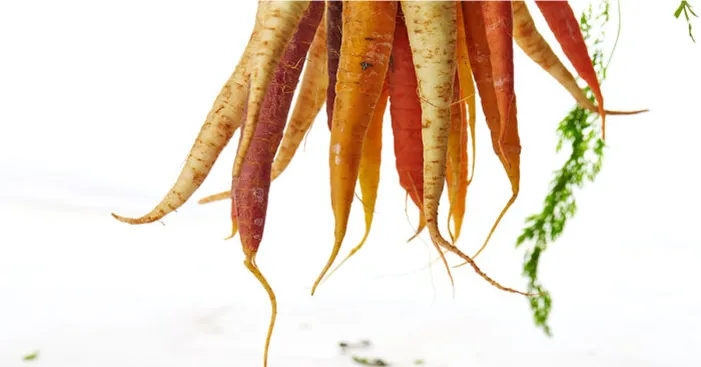Table of Contents

Carrot fiber is a very broad term we mainly use to describe all the fibers in carrots regardless of their type.
On a more general knowledge, we mostly praise carrots for their carotenoid content.
Specialists recommend that we don’t peel carrots too much in order to not waste some of the nutrients.
In fact, some of the fibers in carrots are located in the peel itself.
A carrot contains a lot of essential nutrients such as vitamin A, beta-carotene, alpha-carotene, vitamin B, vitamin C, and vitamin K.
Also, it offers a wide variety of minerals including calcium, potassium, iron, and magnesium.
If you want to learn more about the nutrients in carrots and the benefits we can get from eating carrots, feel free to check the benefits of carrots here.
However, in this article, we are going to focus on the fiber content of carrots, but first:
What are fibers? And what is the carrot fiber content?

Fibers are certain compounds that we can only find in plants and they are essential and critical for our health.
As for the composition, they are made of numerous sugar molecules including fructose, glucose…
Thus, dietary fibers are long chains of carbs often known as “good carbs”.
In fact, the term “dietary fibers” goes back to the time when people believed that these components are not essential nutritionally.
Another fact is that our bodies are not made to digest fibers or absorb them as we like special enzymes for that.
That is the reason why we take no nutrients from fibers regardless of how many apples or carrots we eat.
Fibers come in two categories based on their solubility in water therefore they are either:
Soluble fibers: pectin.
Insoluble fibers: cellulose, hemicellulose, and lignin.
These two categories are both essential for proper gastrointestinal health and we need both of them.
According to the NIH, carrot fiber is made of 81% cellulose, 9% hemicellulose, 7.5% pectin, and 2.5% lignin. (2)
Since pectin is the more abundant soluble carrot fiber, and likewise cellulose is the most abundant insoluble carrot fiber, the next part is going to take these two fibers in detail to explain their health benefits.
Carrot fiber:
Carrot fiber: the soluble fibers

These types of fibers are mostly found in the core of the plant whether it’s in the core of the root, stalk, fruit, seed, or bean.
The best sources of soluble fibers are apples, barley, beans, oats, and carrots.
In the intestines, food residues and the undigested particles stick to soluble fibers.
Then, that combination of food residues, soluble fibers, and water gets attacked by bacteria and degrade and ferment.
The mixture becomes viscous as it ferments which leads to an easier evacuation of food residues as they can slide easily throughout the intestines.
Carrot fiber: pectin
Pectin is an organic plant substance that exists in different types of fruits and vegetables such as apples, carrots, lemons, grapes…
Particularly, pectin constitutes about 7.5% of the carrot fiber and offers about 1g of pectin per two carrots.
Botanically, pectin is responsible for holding the cells together which keeps the structure of the plant together.
Simply speaking, pectins are a structural element of the plant and the basic responsible element for its shape.
In the kitchen, pectin is also used to give the recipe more texture and composer.
The presence of pectin in a product is usually indicated on the package with the reference E440.
The usage of pectin as an additive to any product is totally safe and fully authorized by the FDA and the European Union as well. (1)
Properties of pectin:
- One of the abilities of pectin is its capacity to regulate lipids because it absorbs juices produced by the liver within the intestines, therefore it regulates cholesterol.
- Provides food content without calories this would increase the feeling of satiety and fullness which is good for a weight loss
- Smoothens the digestion process as it absorbs water which facilitates bowel movement by preventing the stool from drying.
- Absorbs fats and sugar within the intestines and reduces their absorption which could also help lose weight.
- Regulates bile acids produced by the liver which could lead to regulating blood pressure.
- Lastly, pectin in carrots has the capacity to absorb certain toxic heavy metals such as mercury which help prevent many diseases.
Carrot fiber: the insoluble fibers

lignin, hemicellulose, and mostly cellulose.
Insoluble fibers are mostly located in the envelope of a plant making the cover that wraps around a part of the plant.
Among the best sources of insoluble fibers are potatoes, cauliflower, broad beans, wheat flour, and carrots.
Insoluble fibers are less vulnerable to bacteria which means they don’t ferment easily.
Insoluble fibers have a very good potential to absorb and control liquids and water in the stomach.
By absorbing excessive liquids in the stomach insoluble fibers increase the volume of the stool and stimulate bowel movement.
Carrot fiber: cellulose
This type of fiber is usually present in the peel of a fruit, some beans, and vegetables as well including carrots.
One of the common uses of cellulose is to make papers and clothes and that gives an idea about its composition and function in a plant.
This type of fiber is considered a carbohydrate and it is not digestible by humans which is why it offers no energy value.
Nonetheless, it is very necessary for the proper functioning of the intestines.
Cellulose also contains glucose but this shouldn’t be a problem as we do not digest cellulose and that applies to its glucose as well.
In fact, cellulose goes throughout the digestive tract without being processed.
You may think then why do we even need something that we won’t digest and get nutrients from?
Well, part of the digestion process is also getting rid of excessive water and food residues.
Think of it, if we digest some of the food and the rest is left in the body, it will obviously ferment and go rancid which will end up harming us.
Cellulose acts in a way that stimulates the contraction of the intestines which helps the bacterial activity within the colon.
In the food industry, many products use cellulose as a texture agent to add more thickness and it goes by the reference E460.
Properties of cellulose:
- Cellulose also prolongs the feeling of fullness which gives us more control over our appetite and that is helpful to lose weight.
- Provides a laxative effect and that ends up making the intestinal transit a smoother function.
- A great remedy for constipation by consuming cellulose-rich food such as carrots, flaxseeds, hemp seeds, chickpeas, asparagus … and then drinking a lot of water.
Notices:
- Whole fruits tend to have more cellulose content than juices as the blending process breaks down fibers.
- Cooking cellulose-rich food makes the fiber content easier to digest and probably steamed fruits or vegetables are the best sources of cellulose.
Benefits of carrot fiber:

Dietary fibers are very essential for our bodies as they play many key roles in our health.
Not only do fibers act on many body functions, but they also reduce mortality risks from infections, cardiovascular issues, and respiratory diseases.
Here are the main benefits you would get by consuming more carrots:
Good to treat constipation:
Whether insoluble or soluble, fibers have a good effect on the movement of the stool within the intestines.
This is because fibers tend to absorb a lot of water and end up swelling and turning into a gel form.
This results in a more viscous mixture of gel-like food residues and fibers which is easier to evacuate.
However, in order to activate this property of fibers we have to drink a sufficient amount of water.
Reduces bad cholesterol LDL:
Dietary fibers trap lipid molecules and prevent the body from absorbing them which reduces bad cholesterol.
As a result, most of the bad cholesterol is eliminated through defecation before making it to the bloodstream.
That is really good as the body would use the rest of the cholesterol that already circulating in the body.
When we consume enough fibers regularly, the body uses most of the circulating cholesterol and ends up regulating it.
Consequently, the body is less vulnerable to cardiovascular diseases including heart disease, strokes, blockage of the arteries (atherosclerosis).
Lowers the glycemic index:
Again, dietary fibers have the ability to reduce the absorption of certain nutrients such as carbs.
This means that a diet rich in fibers tends to have a lower glycemic index and that means a reduction in blood sugar levels.
In the long run, a diet that has enough fibers (30g a day at least) has a lower risk of getting type 2 diabetes.
May protect against cancer:
As mentioned above, fibers are able to trap some of the harmful heavy metals that we may ingest unknowingly.
Basically, a diet rich in fibers gives us a more flushing ability to flush out harmful chemicals before they make it into our system.
You may be wondering why would anyone consume toxins but those chemicals exist in pesticides used in agriculture.
By flushing out those harmful chemicals, the body is at a lower risk of getting digestive cancers such as colorectal cancer.
You may be thinking about good minerals and what if we end up flushing those as well?
This shouldn’t be a concern, as usually food that is high in fibers like carrots tend to have more minerals than low-fiber food.
Therefore, it is very unlikely to experience minerals deficiency as long as the person follows a balanced diet.
Extends the feeling of fullness:
Once the fibers swell within the digestive tract, the digestion process becomes slower as gastric bowl volume is bigger.
Thus, the bowl is fuller for a longer time and that allows us to eat less during mealtime.
This also postpones the feeling of hunger between the meals and this is very beneficial for those who want to lose weight.
How many fibers do we need per day?

Not only do they help control the appetite, but fibers are also responsible for the stool volume by retaining water.
Generally, the diets we follow offer too little fiber content as we only consume between 6 and 20g fibers a day.
Whereas, the recommended daily intake of fibers should be at least 30g.
By eating just two carrots a day, you will get about 15% of your daily need in fibers which is a good boost to reach the recommended value.
This doesn’t mean that we need to consume 7 or 8 carrots a day, because we do eat other sources of fibers.
Therefore, to help reach the daily need in fibers we can introduce more carrots in our diets.
Precautions you need to know about carrot fiber:

Any type of food is generally safe to eat in a moderate with few exceptions of allergies…
However, eating too many fibers or not enough fibers could lead to bad health issues.
Effects of a diet too rich in fibers:
Let’s get this right: eating too many fibers is not toxic!
Nonetheless, when we consume a lot of fibers it may cause digestive complications such as nausea, bloating, diarrhea…
This is very unpleasant especially for people with sensitive intestines which is why they need to increase fiber intake gradually.
Many people who suddenly increase their fiber intake end up experiencing flatulence (AKA farting).
This is completely normal, as intestinal bacteria have more fibers to ferment which leads to more gas production.
However, this effect reduces over time as the body adapts to the new change in the diet.
As a recommendation, it is better to ingest fibers from cooked sources instead of raw sources as that makes them easier to process.
Effects of a diet too low on fibers:
On the other hand, a diet too low in fibers may lead to constipation as the stool tend to dry out without water retention.
To this day, there are no known diseases in link to fiber deficiency.
However, it may lead to a lower ability of the body to get rid of excess cholesterol and sugar which may lead to type 2 diabetes and hypercholesterolemia.

I’ve been reading on fiber and not entirely understanding it for the past 2 years…until now. EXCELLENT explanation. You seriously probably just saved my life. Diagnosed with ms a few years ago and haven’t been able to figure out what I wasn’t digesting correctly until now. Thank you!
Thank you Sarah!
We’re really happy that you find value in our work!
That is the whole reason why we built “foodieleaks”, to be the link between academic science and food, to try and simplify what modern science says about certain food we eat and break down the complicated terminology with simple words that can be easily understood.
We wish you a healthy long life!
Fabulous article. Thanks for this great level of detail.
Would you say that steamed carrots have the same soluble/insoluble fiber properties and amounts as boiled carrots?
Thank you! We’re so happy that you find good knowledge in our article, we truly appreciate your feedback!
Question:
Would you say that steamed carrots have the same soluble/insoluble fiber properties and amounts as boiled carrots?
Answer:
Fibers are the main components that keep carrots crunchy and solid. This means that fibers will most likely breakdown the longer you cook your carrots. It makes no difference whether you steam or boil them to the point where they are too soft, in both scenarios you’re going to be left with little to no pectin and cellulose. If you want to get carrot fibers, the best way is to consume them raw and if you insist on cooking them, try steaming them for a short time until they become just a little soft and still feels crispy, this way you’ll still have some beneficial fibers in them!
Thank you for your question and we hope we were able to provide some good information.